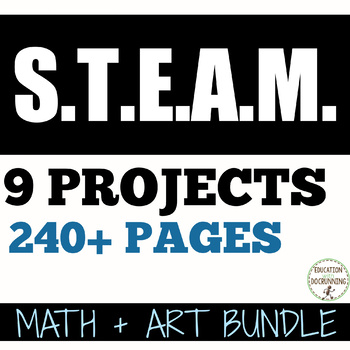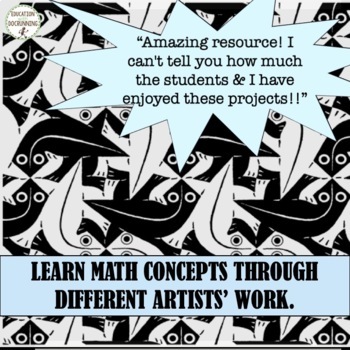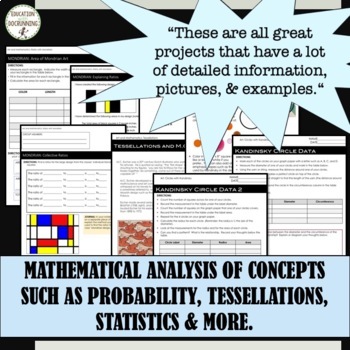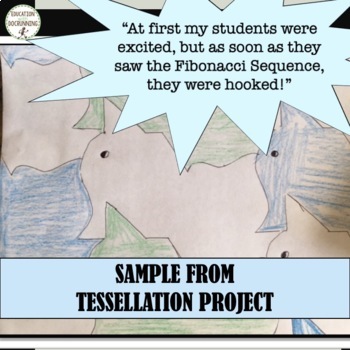Math Projects Middle School Bundle for STEAM
- Zip
- Easel Activity
Products in this Bundle (8)
showing 1-5 of 8 products
Bonus
Description
Jump into middle school math concepts with this Art meets math bundle of creative math projects. Great for math lab days or stations. 8 Math meets arts lessons + a bonus resource of linear equations with Calder ($45 VALUE).
Each project includes:
- Teacher's guidelines
- Background information on artist
- Student handouts for each part of the project
- Answer key (where applicable)
- Editable rubric (where applicable)
- Slides or artwork related to project
This bundle includes:
- Rational vs. Irrational Numbers: a set of 3 kinesthetic activities.
- Circles and Area with Kandinsky
- Fibonacci Spirals: scale and number pattern
- Area, Perimeter and Ratio with Mondrian
PLUS a bonus of One-Step Linear Equations with Calder Mobiles (Not available elsewhere)
Over 6 weeks of projects to integrate throughout your math year and all common core aligned as well. Use whole class, with individuals, or at math centers. Each of these lessons are available individually as well. Perfect for differentiation with your gifted elementary students, too!
Skills Include:
- Students will explain each step in solving a simple equation as following from the equality of numbers asserted at the previous step (CCSS.MATh.CONTENT.HSA.REI.A.1)
- Students will solve simple rational and radical equations in one variable (CCSS.MATh.CONTENT.HSA.REI.A.2).
- Students will solve linear equations in one variable including equations with coefficients represented by letters (CCSS.MATh.CONTENT.HSA.REI.B.3)
-Students will describe relationships of inscribed circles.
- Students will know the formulas for area and circumference of a circle and use them to solve problems. (CCSS.MATH, 7.G.B.4.)
- Students will solve mathematical problems involving area of 2-dimensional objects composed of quadrilaterals and triangles.
- Students will summarize numerical data sets in relation to their context (CCSS.MATH.6.SP.B.)
- Students will report the number of observations in data collection (CCSS.MATH.6.SP.B.5.A.)
- Students will develop quantitative measures to analyze data and describe the pattern (CCSS.MATH.6.SP.B.5.C.)
- Students will understand that statistics can be used to gain information about a population by examining a sample of the population and generalizing about a population based on that sample (CCSS.MATH.7.SP.A.)
- Students will summarize numerical data sets in relation to their context (CCSS.MATH.6.SP.B.)
- Students will report the number of observations in data collection (CCSS.MATH.6.SP.B.5.A.)
- Students will develop quantitative measures to analyze data and describe the pattern (CCSS.MATH.6.SP.B.5.C.)
- Students will understand that statistics can be used to gain information about a population by examining a sample of the population and generalizing about a population based on that sample (CCSS.MATH.7.SP.A.)
- Students will use deductive reasoning to define common characteristics between geometric figures (CCSS.Math.Content.G)
- Students will understand that a two-dimensional figure is similar to another if the second can be obtained from the first by a sequence of rotations, reflections, translations, and dilations (CCSS.Math.Content.8.G.4.A.).
- Given two similar two dimensional figures, students will describe a sequence that exhibits the similarity between them (CCSS.Math.Content.8.G.4.A.).
- Students will model knowledge of number pattern in art activity (CCSS.Math.Practice.MP4)
- Students will reason with shapes and their attributes (CCSS.Math.Content.8)
- Students will draw and identify lines and angles and classify shapes by properties (CCSS.Math.Content.8)
- Students will verify experimentally the properties of rotations, reflections and translations (CCSS.Math.Content.8.G.A.1)
-Students will identify the properties of irrational numbers (CCSS.MATH.CONTENT.8.NS.A.1)
This purchase is for one teacher only. This resource is not to be shared with colleagues or used by an entire grade level, school, or district without purchasing the proper number of licenses. If you are interested in a site license, please contact me for a quote. This is for use with your students only.





